TL:DR
Improvado is an ETL (Extract, Transform, Load) platform designed to unify marketing data from various sources. While powerful for data aggregation and transformation, it lacks native, client-ready reporting and visualization capabilities, often requiring integration with other BI tools.
Who it’s best for:
Technical teams, large enterprises, or agencies with existing BI infrastructure and a dedicated data team who prioritize a flexible data pipeline over an all-in-one reporting solution.
Key features at a glance:
| Feature | Improvado |
| Integrations | 500+ connectors, but some require manual development or credits |
| Stable connections | No-code module for cleaning, mapping, and joining datasets |
| Ease of use | Steep learning curve; not beginner-friendly due to its technical focus and dated interface |
| Data blending | Available, but limited control compared to full-service platforms |
| Internal dashboards | Basic and utilitarian; not suitable for client presentations or deep insights |
| Customizable reports | No native robust reporting; requires external BI tools for polished, custom reports |
| Report sharing & automation | Not an inherent feature; relies on integrated BI tools for these functionalities |
| Security | SOC 2 Type II certified, GDPR and HIPAA compliant, offering granular role-based access |
Pros ✅
- Extensive library of 500+ marketing data connectors
- Powerful data cleaning and transformation capabilities
- Flexible in pushing data to various destinations
- Strong security and compliance features (SOC 2, GDPR, HIPAA) with granular role-based access
- Responsive and helpful customer support, especially for higher-tier plans
Cons ❌
- Significant ramp-up time for implementation (average 2 months)
- Not an all-in-one reporting solution; requires pairing with BI tools for visualization and client reporting
- Steep learning curve and technical expertise required; not suitable for non-technical marketers
- Inconsistent data syncs and lack of clear status information for data extractions
- Dated and functional-first user interface
Why You Can Trust This Review
At Whatagraph, we spend every day deep in marketing data—so when we review a tool like Improvado, we know the pain points, the use cases, and the “gotchas” marketers run into with complex reporting stacks.
Now, Improvado isn’t a self-serve platform. You can’t just sign up and poke around. Their onboarding is hands-on and customized, which means no standard free trial or sandbox access unless you’re a qualified lead.
So, here’s how I did my homework:
- Scoured user feedback: I went deep on Reddit, YouTube, X, Quora, and community forums to hear directly from marketers using Improvado in the wild.
- Read 100+ verified reviews: I combed through platforms like G2, TrustRadius, Capterra, and GetApp to see where Improvado shines—and where users get stuck.
- Pored over Improvado’s documentation: I read their pricing pages, product guides, support articles, and setup FAQs to get a clear sense of what’s included, what’s custom-built, and what’s extra.
Our goal is to help you make an informed decision, whether that leads you to Improvado, to Whatagraph, or to another solution entirely.
Improvado Pricing
Improvado doesn’t list fixed prices on their site. Instead, you’ll need to book a demo to get a quote tailored to your needs. What we do know is that pricing is structured across three tiers—Growth, Advanced, and Enterprise—and most advanced features are credit-based add-ons.
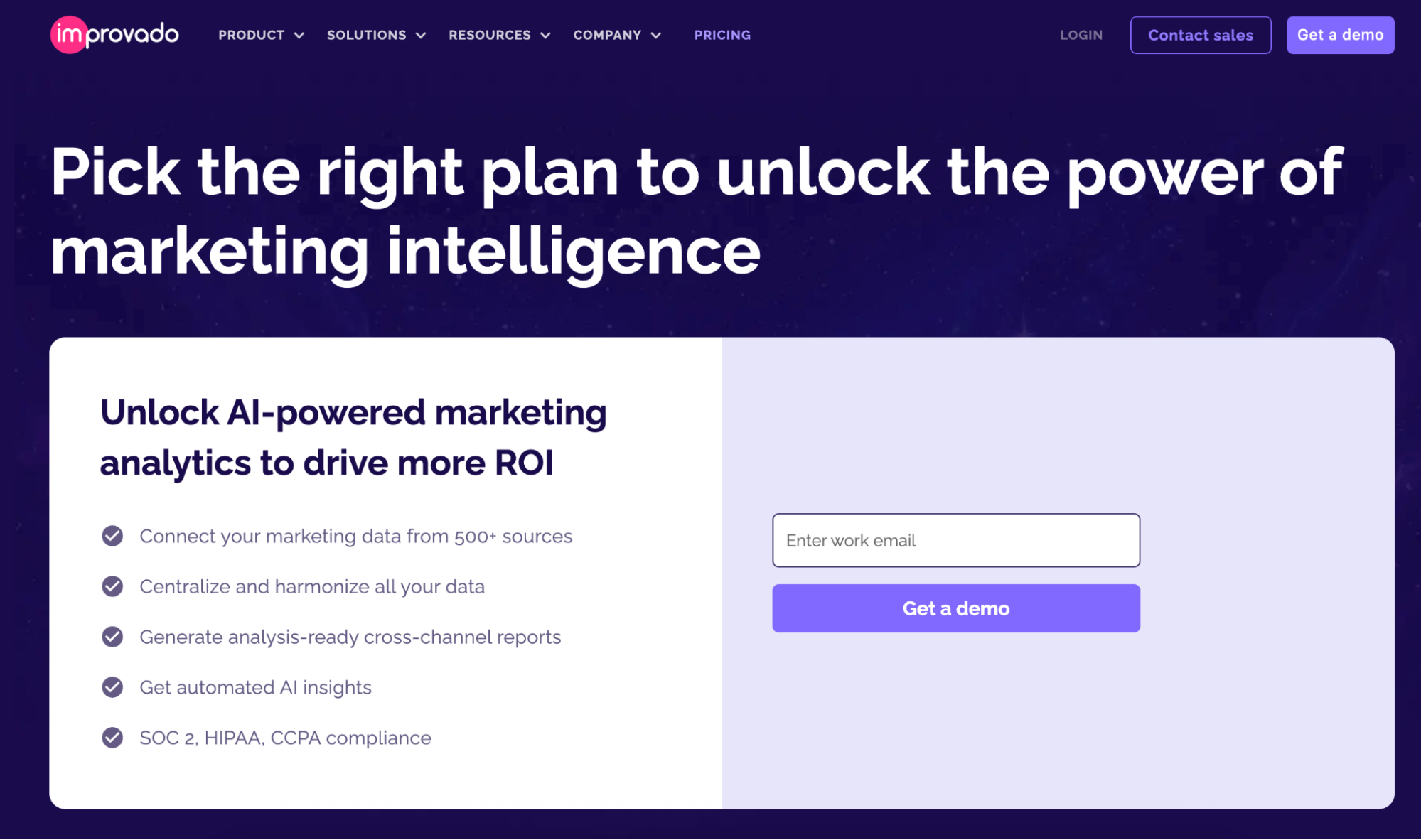 Here’s how the plans break down:
Here’s how the plans break down:
Plan | Data Volume (Unique Rows/Year) | Sync Frequency | Support |
| Growth | Up to 200M | Up to 2x/day | Standard support (10/5) |
| Advanced | Up to 600M | Up to 4x/day | 20 hours/month managed services (if applicable) |
| Enterprise | Up to 1B | Custom | Premium support (add-on) |
Heads up: Improvado uses “credits” for most custom requests, like building new data sources, destinations, or dashboards. You’ll also need credits for access to add-ons like AI Agent, data governance modules, or professional services.
Improvado doesn’t publish pricing publicly, so you’ll need to book a demo to get an exact quote. That said, we do have real-world intel based on verified reviews from G2.
Here’s what users typically report:
- Time to implement: ~2 months
- Average ROI timeline: 15 months
- Average discount negotiated: 14%
- Perceived cost: $$$ (mid-tier)

Key takeaways for your budget
- Calculate your total cost of ownership (TCO): Improvado is an ETL tool, not a full-blown business intelligence platform. That means you’ll likely need to pair it with another tool (like Looker Studio or Tableau) to build client-ready dashboards and run advanced analysis.
- Factor in the two-month ramp-up time: Implementation takes around two months on average. That’s two months of setup, onboarding, and internal alignment before you see value. And while Improvado’s perceived cost sits in the mid-tier range, that delay can hit harder for startups or lean teams trying to move fast on tighter budgets.
Real User Reviews: What are Customers Saying About Improvado?
Reddit threads, YouTube demos, Quora debates, X hot takes—you name it, I read it.
Then I cross-referenced all that raw, unfiltered chatter with more structured reviews from G2, Capterra, and GetApp. But software moves fast.
A glowing write-up from 2021 doesn’t mean much if the product’s shifted since then.
So for this section, I focused only on reviews from 2024 and 2025: the most recent, most relevant feedback that reflects where Improvado actually stands today.
Improvado pros: What users love
✅ Support that’s responsive and genuinely wants to help
Whether it’s a bug, a blocker, or just a quick clarification, multiple users praised the support team’s hustle.
Improvado's customer relationships and willingness to go above and beyond really sets them apart.
✅ Control over your data picture
Improvado doesn’t lock you into a black box. You can build custom APIs to fill in gaps, pair them with pre-built connectors, and craft a data pipeline that’s tailored to your specific needs.
Sid G., Digital Marketing Manager, says:
The ability to create custom APIs, combined with Improvado's existing connections, has given us a complete and accurate view of our business.
✅ Handles cross-channel complexity
One verified user pulled in data from two email platforms, Google Analytics, and both paid and organic social across five platforms, and Improvado kept up.
Improvado can be a powerful analytics tool for a variety of marketing channels (we chose 2 email providers, Google Analytics, organic and paid social for 5 platforms).
Improvado cons: Where users get frustrated
❌ A steep learning curve
Multiple users flagged this: Improvado isn’t beginner-friendly. If you’re a solo marketer or don’t have developer support, expect a bumpy ride. From setup to customization, there’s a heavy technical lift.
“It requires technical experience. I wouldn't say this is a tool marketers or beginners can use. You'll need a developer depending on what you are looking to do.”
❌ Dashboards don’t always deliver real insights
Some users found the native dashboards underwhelming. You might need another tool layered on top (or a lot of customization) to actually surface actionable insights.
A recent verified review says:
Unable to truly gather insights from the dashboards provided.
❌ Inconsistent data syncs and unclear reporting status
Data delivery can be unreliable depending on your sync settings, and users noted a lack of visibility into what’s running, failing, or stuck. That’s a headache when you’re chasing deadlines.
A verified user shares that there’s “too much push for AI,” as well as “inconsistent data delivery based on the settings selected. Lack of reporting / status information for data extractions.”
What Does Improvado Genuinely Do Well?
Improvado bills itself as an AI-powered marketing intelligence platform, promising a unified view of marketing ROI and performance. But if you peel back the buzzwords, at its core, Improvado is an ETL platform: Extract, Transform, Load.
That means it’s built to move data from all your scattered sources (like Meta, HubSpot, Google Ads, Salesforce, etc.), clean it up, and pipe it into a final destination—your data warehouse, your dashboarding tool, or your BI setup.
- Extract: Improvado offers 500+ prebuilt data connectors across ad platforms, CRMs, analytics tools, and more. Build custom connectors using their API or request them through support—though this will cost you credits.
- Transform: The no-code data transformation module lets you normalize naming conventions, clean up messy fields, map metrics across platforms, and join datasets together. You also get prebuilt pipelines and dashboards (1 on Growth, 2 on Advanced, 4 on Enterprise), but the real power comes when you tap into custom workflows built by Improvado’s team—again, powered by those customization credits.
- Transform: Once transformed, Improvado can push data to cloud warehouses like Snowflake, BigQuery, Databricks, or MS SQL, dashboard tools like Looker Studio or Tableau, or even directly into your own product via their Management API.
You can set up concurrent destinations (2 on Growth, unlimited on higher plans), and even geo-restrict data processing to comply with US or EU data residency.
Improvado shines when you need a flexible, customizable pipeline to move marketing data from Point A to Point B.
But still—it’s only one tool in your marketing analytics tech stack. Say you want automated reporting for your paid campaigns. Sounds simple enough until suddenly you’re using Improvado for ETL, Looker Studio for dashboards, Google Sheets for last-minute tweaks, and maybe even Slack to ping updates.
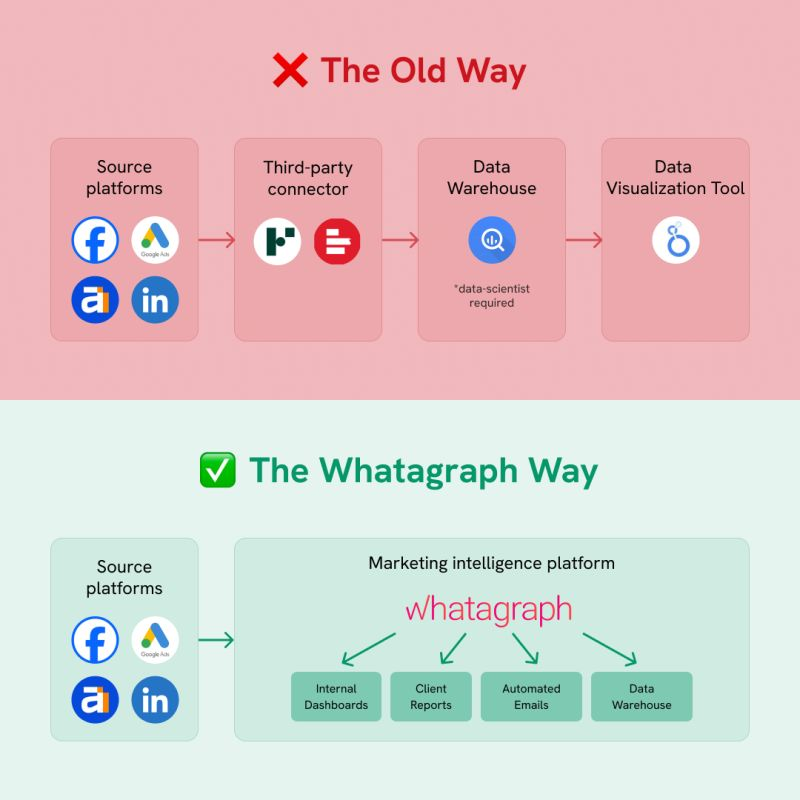
That’s what I call a “Frankenstack.”
Add to that the cost of managing all those platforms—subscription fees, maintenance, setup time, plus Improvado’s credit-based pricing model—and your TCO starts to quietly pile up.
If you’re just looking for clean pipelines to push data into your stack, Improvado does that well. But if you’re looking for a single, unified reporting workflow, you may need to keep building around it. Or look elsewhere for an all-in-one marketing reporting solution like Whatagraph.
Improvado Deep Dive #1: Data Pulling and Connectors
Connectors are what allow a tool like Improvado to pull data from all those platforms into one central source. They eliminate the need for CSV exports, midnight spreadsheet merges, and context loss across tools.
Let’s see how Improvado fares in breadth and reliability.
How many out-of-the-box integrations are there?
Improvado integrates with 500+ marketing data connectors, which sounds impressive on paper. You'll find big names like HubSpot, Mailchimp, Google Ads, Meta, Mixpanel, and Stripe baked right in, along with ecommerce heavyweights like Shopify.
But not all of those 500+ connectors are native.
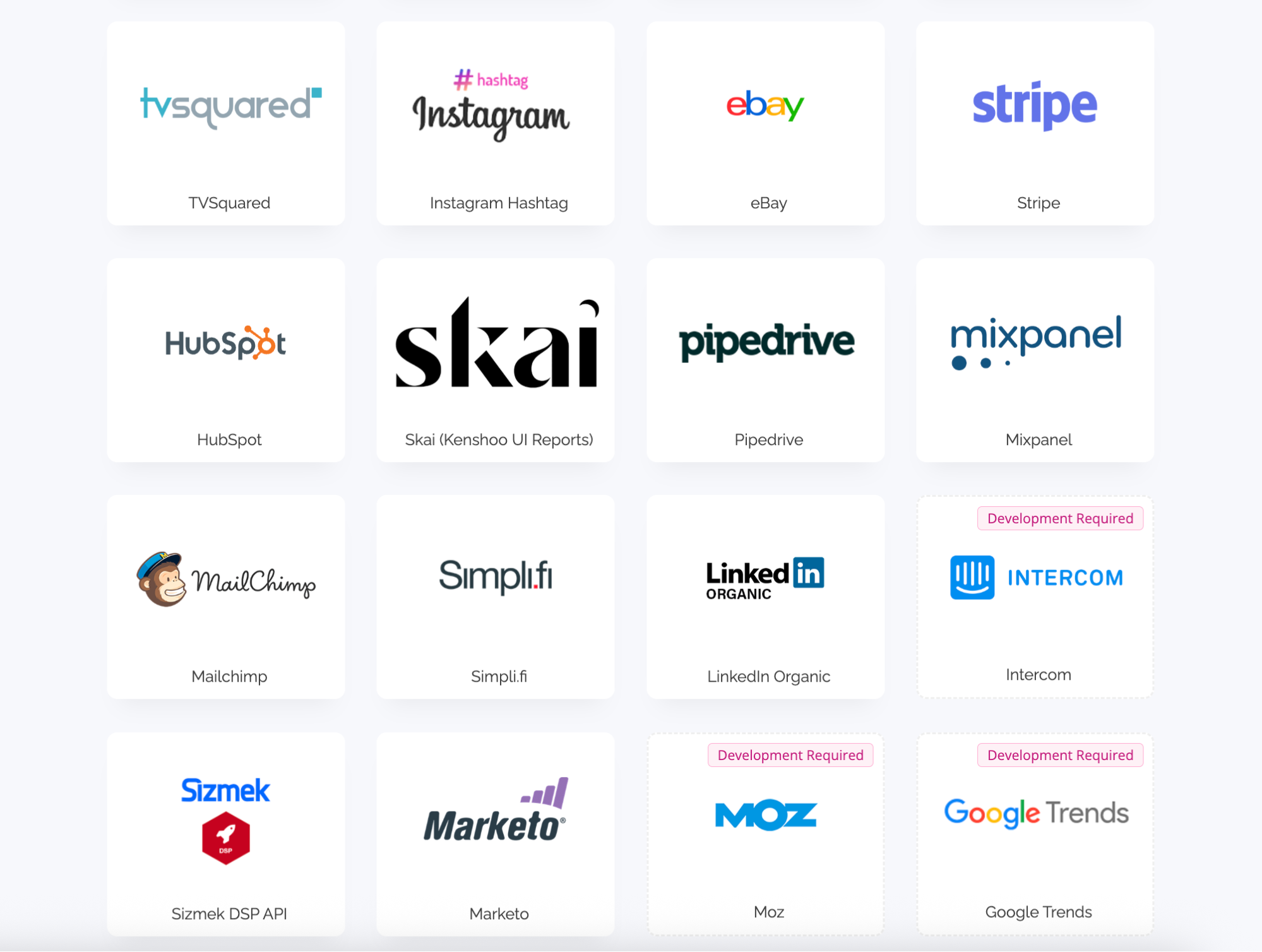 Some, like Google Trends, MOZ, and Intercom, come with a "Development Required" label, which means your team (or Improvado’s) will need to build the connection manually. That’s a red flag if you're depending on those platforms for client deliverables or campaign tracking.
Some, like Google Trends, MOZ, and Intercom, come with a "Development Required" label, which means your team (or Improvado’s) will need to build the connection manually. That’s a red flag if you're depending on those platforms for client deliverables or campaign tracking.
More importantly, some major connectors are missing entirely. SE Ranking, a core SEO platform for many agencies, isn’t supported at all. (Whatagraph does, BTW.)
To Improvado’s credit, they do offer a “we’ll build it for you” policy if a connector is missing. But that’s dependent on your support tier, uses customization credits, and adds time to your marketing team’s onboarding.
How reliable are these connections day-to-day?
This is where the shine starts to dull a bit.
While Improvado’s connectors are powerful in theory, several users have flagged inconsistent data delivery: especially when syncing across multiple platforms with different settings.
One reviewer even pointed out that data extraction status information is missing, so if something breaks or stalls, you won’t know right away. You’re left guessing (or Slack-pinging support) when dashboards stop updating.

The connectors are wide-reaching, but not always hands-off. You’ll likely need a process in place—or a point person—to monitor data health day to day to streamline reporting.
Improvado Deep Dive #2: UX and Usability
I didn’t get hands-on access to Improvado (they don’t offer a standard trial), so I did the next best thing: I went digging through their official YouTube channel.
I watched walkthroughs of real use cases—like how to connect Improvado to Tableau—and paused to study the interface via screenshots.
Note: Their videos haven’t been updated in over a year. And from what I could see, the interface hasn’t aged well. The Help Center doesn’t offer fresh user interface screenshots either.
Is the interface intuitive and modern?
Not exactly.
What stood out to me wasn’t just how you move through the tool, but what’s missing from the experience.
Because if one of your primary tutorials is “how to send your data to another platform for data visualization,” that tells me something important.
Improvado’s interface feels more functional than friendly. It’s built for data processing, not for day-to-day usability. You won’t find much polish here: no modern UX touches, no clean visual hierarchy, no thoughtful guidance baked in. It’s dense, “backend-y,” and honestly, a bit dated.
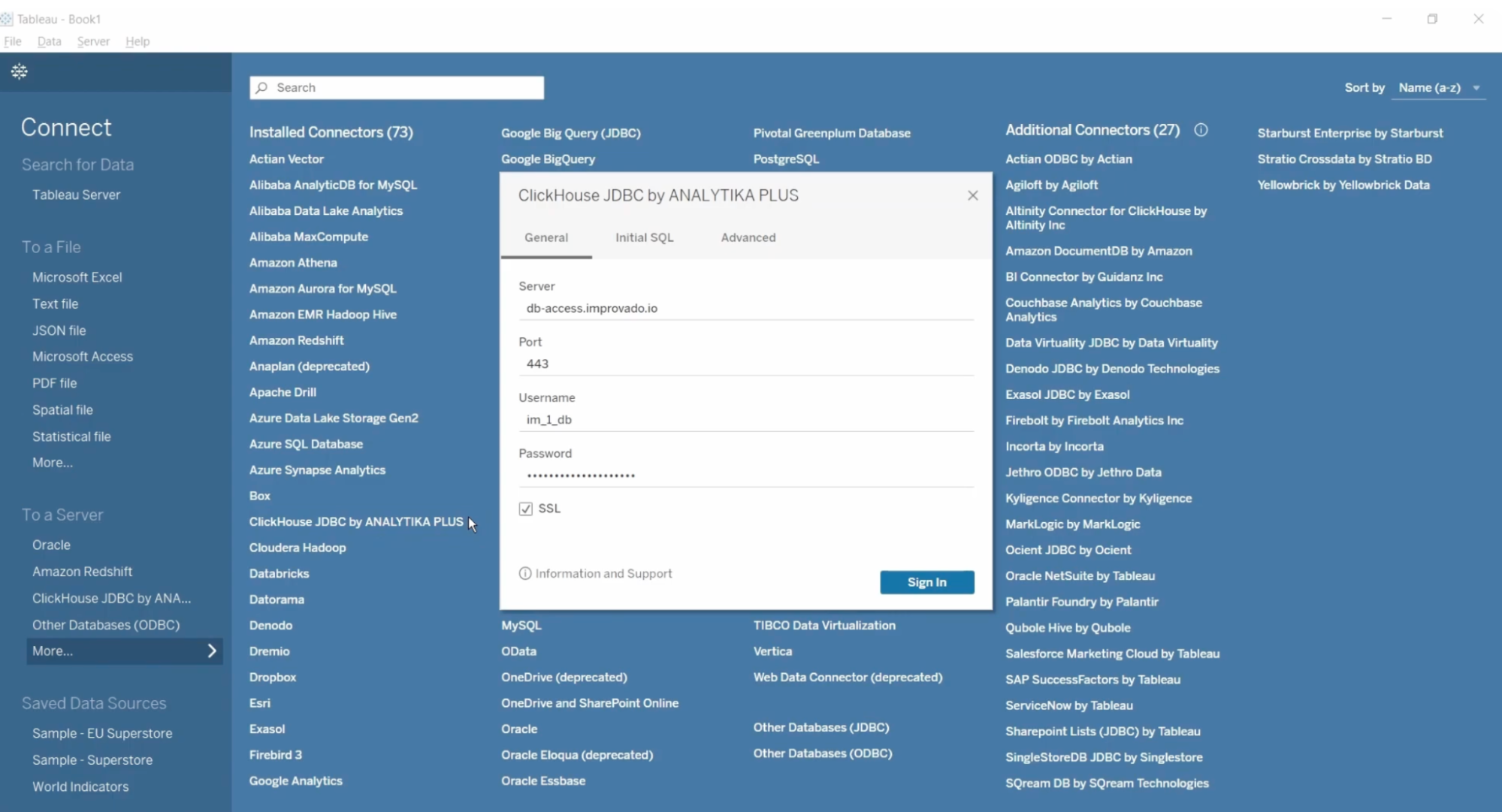 The left-hand navigation menu is crammed with dense, utility-first labels: "Extraction Templates," "Data Explorer," "Service Desk." The color palette is dark and saturated, which can be visually jarring for sensitive readers or anyone skimming data for hours at a time.
The left-hand navigation menu is crammed with dense, utility-first labels: "Extraction Templates," "Data Explorer," "Service Desk." The color palette is dark and saturated, which can be visually jarring for sensitive readers or anyone skimming data for hours at a time.
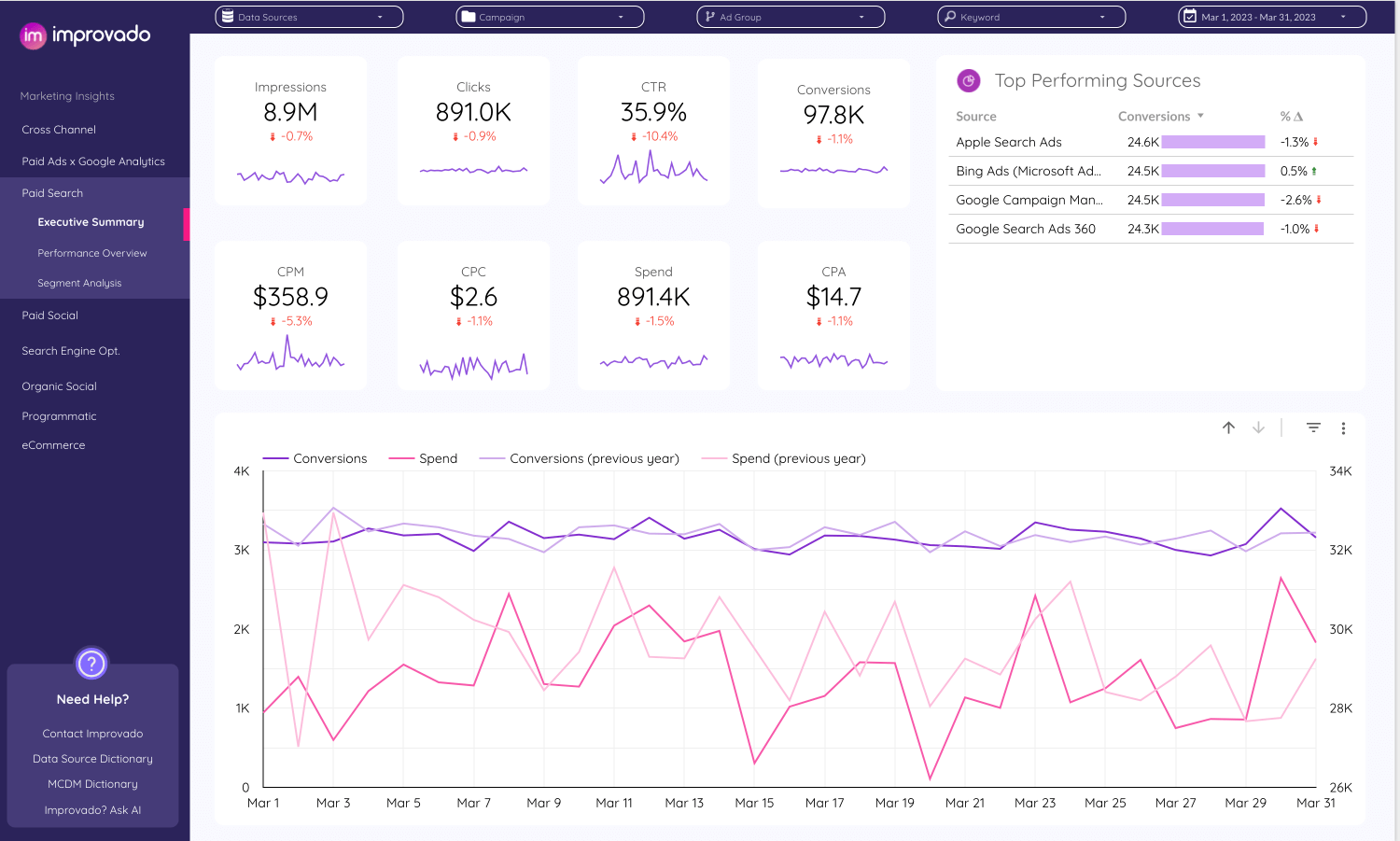 You either know where you’re going—or you’re Googling how to get there.
You either know where you’re going—or you’re Googling how to get there.
If you’re used to sleek tools like Notion, Airtable, or even Whatagraph, this will feel clunky. And for visual thinkers or non-technical marketers, the learning curve is steep and uninviting.
When I say Improvado’s interface isn’t “modern,” I mean it in direct contrast to tools like Whatagraph that are built for usability, where design actively supports the workflow:
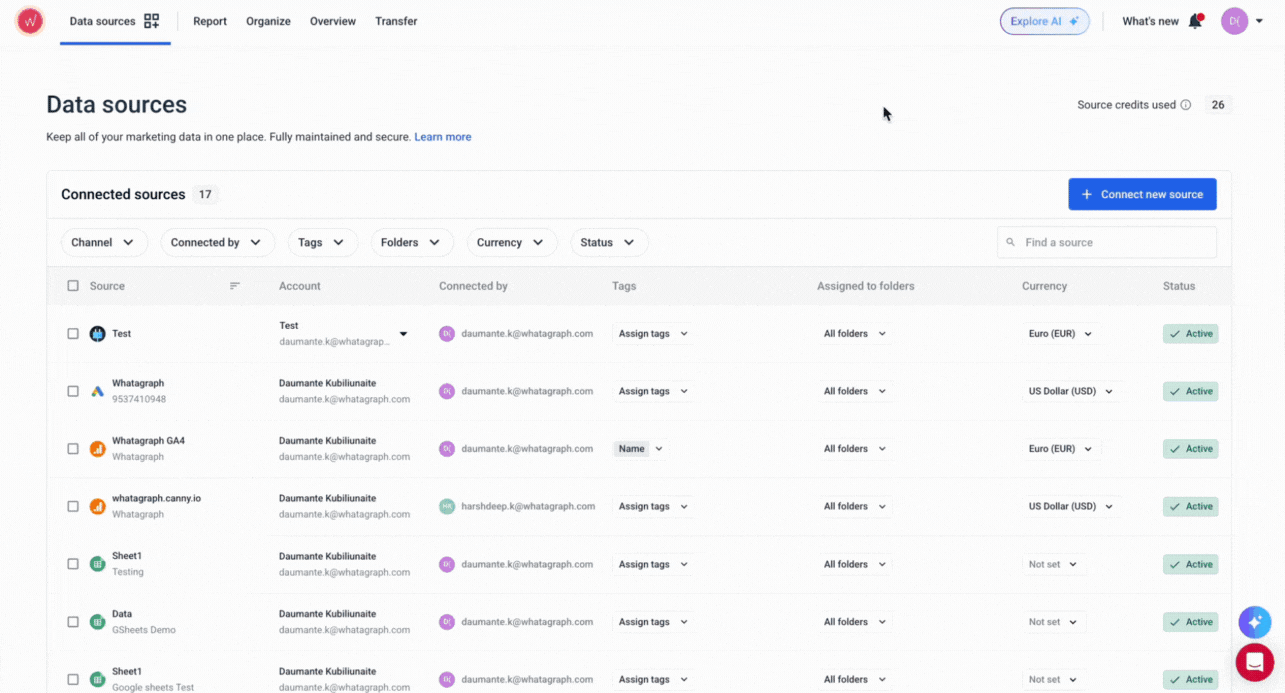
Here’s the difference in one word: approachability.
With Whatagraph, you don’t feel like you’ve stepped into a developer’s staging environment. You see your data sources at a glance. You know exactly what’s connected, what’s active, and what your next step is.
You know what you need to do next without hunting through nested menus or decoding backend labels.
Is it truly beginner-friendly for everyone on your team?
The ease of use factor is pretty low.
When I say beginner-friendly, I don’t mean “a data analyst can figure it out eventually.” I mean a generalist, a junior hire, or even an intern should be able to log in, access reports, and make confident, data-driven decisions without pinging the developer team.
That’s not the case with the current set of features of Improvado.
Even something as fundamental as connecting Tableau requires JDBC drivers, install paths, and manual server configuration.
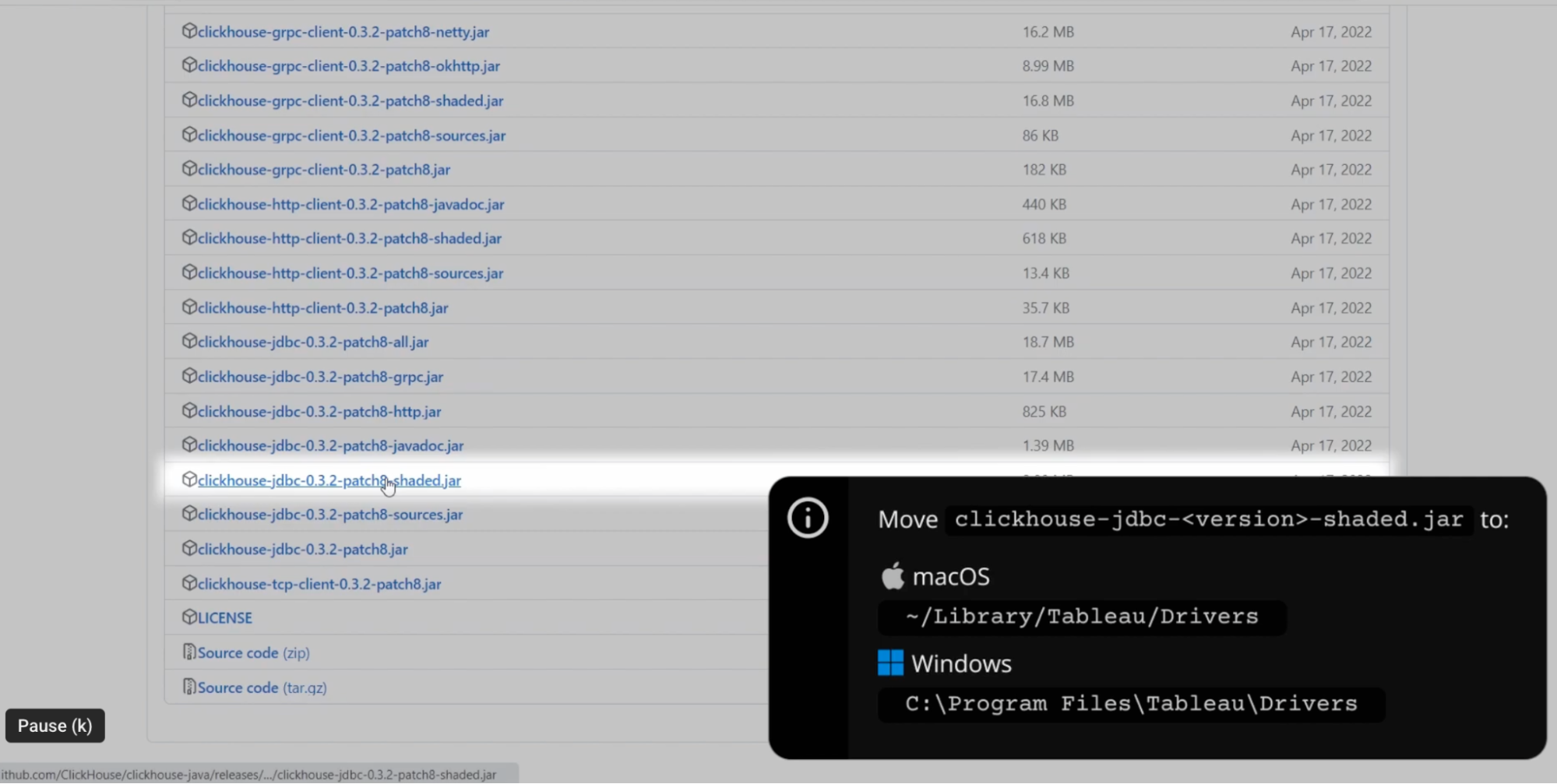 If your team doesn’t have technical support in place, expect to hit some friction early—like other real users did:
If your team doesn’t have technical support in place, expect to hit some friction early—like other real users did:
“There is a heavy technology lift to get this tool going.”
Improvado is powerful under the hood, but not built for everyday marketers. The interface feels more backend than intuitive, and even basic actions require technical know-how.
Improvado Deep Dive #3: Visualization and Reporting
A good data visualization tool bridges the gap between raw data and real-world impact.
So with that in mind, how does Improvado stack up?
Can Improvado dashboards actually impress your clients?
Short answer: no—not on their own.
Improvado offers basic in-platform dashboards: think performance metrics, attribution tables, billing charts. But they’re utilitarian rather than polished. They’re sticky for internal use, but far from the sleek, branded reports your clients expect.
In practice, if you're preparing a client deliverable or stakeholder presentation, you’ll export data or sync to Tableau, Looker, or Power BI—adding steps, complexity, and potential formatting errors. Improvado puts the data in your pipeline but it doesn’t package it up into a presentation.
The most recent Improvado feedback on public forums takes issue with their dashboards specifically:

Look at this head-to-head comparison between Improvado vs. Whatagraph dashboards:

⬆️ What you’re seeing here is a marketing dashboard that’s heavy on data: great for performance monitoring, not so much for storytelling. Metrics like CTR, CPM, and Conversions are all here, but the layout reads like a data warehouse output: tightly packed, deeply nested, and designed for someone who already knows what they’re looking at.
Now compare that with Whatagraph’s dashboard ⬇️:
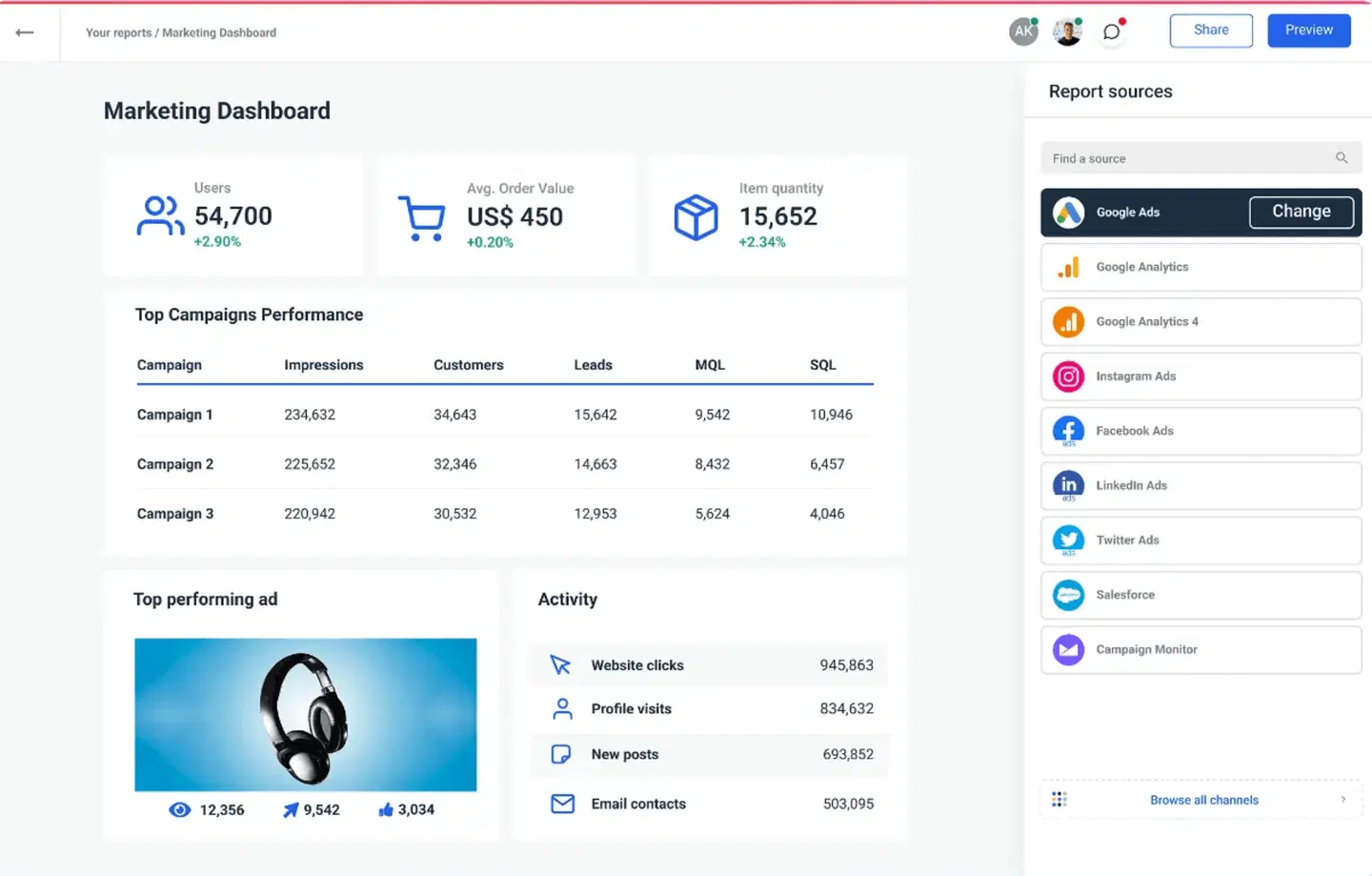
It’s clean. It’s visual. And it immediately tells you what matters: users, order value, SQLs, campaign performance, all broken down into crisp tiles. The sidebar shows connected sources in plain English, and the top bar guides you through building or previewing reports without any code or jargon.
And now with Whatagraph IQ, you don’t even have to build reports manually anymore!
Here’s what that looks like in real life:
✅ IQ Report: Spin up entire reports from a single prompt: pre-filled with layouts, widgets, and the metrics you care about.
✅ IQ Theme: Upload a screenshot of a brand guide, or type what you want, and the platform auto-applies the fonts and colors. Stay on-brand in seconds.
✅ IQ Summaries: Auto-generate clean, client-ready insights in 18 languages.
✅ IQ Chat: Ask, “How did our Meta ads perform last quarter?” and get a real answer—in seconds—straight from your live data.
✅ IQ Dimensions: Group campaigns by funnel stage or region by just describing it. Whatagraph creates clean, consistent dimensions without the mess.
Can you customize and white-label reports without jumping to another tool?
Technically, yes. But it’s not exactly effortless, and it’s definitely not self-serve, according to their documentation.
Improvado offers a whitelabeling feature, but it’s primarily about branding the platform interface, not customizing or designing reports themselves.
You can:
- Replace the logo, favicon, and color scheme.
- Use a custom domain like insights.clientname.com.
- Remove visible references to Improvado.

But even for this simple functionality, you’ll need to contact support, follow detailed DNS instructions, and provide formatted assets (like a 480x180px transparent logo and a DNS CNAME record).
If you're not familiar with setting up subdomains or poking around in a control panel, it’s not exactly beginner-friendly.
The Whatagraph advantage: Improvado gives you a white-labeled backend. Whatagraph gives you white-labeled reports.
Whatagraph treats branding like a first-class feature. You get control at three levels:
- Global team level: Set a default brand theme across all reports your team creates: fonts, colors, layouts, the works.
- Report level: Apply custom branding for individual clients or campaigns. Each report can have its own look.
- Widget level: Tweak the visuals of individual blocks so they tell your story your way.
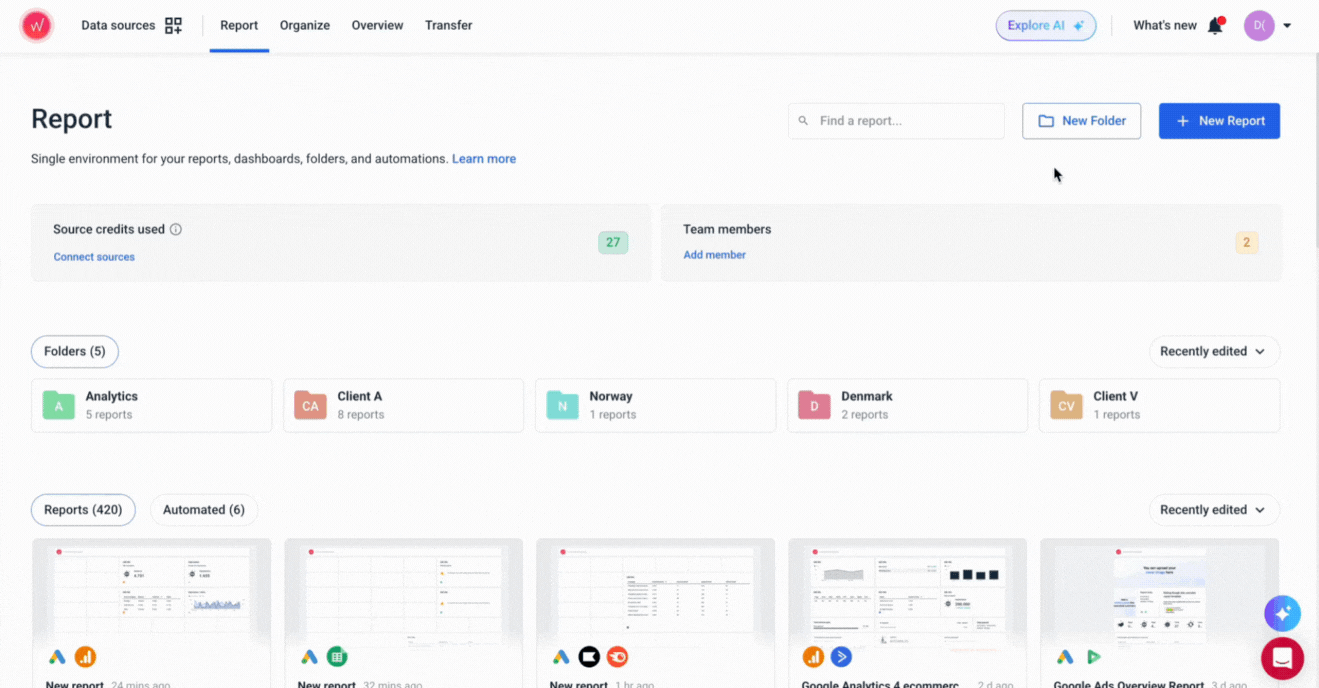
And then there’s the custom domain feature.
Swap out the default Whatagraph URL for something like “reports.youragency.com,” so automated emails come from you, not a third-party. Clients see your name in the sender field. The report feels like it came from your team…because it did.
Improvado lets you white-label the platform interface: logos, favicon, color scheme, and even a custom subdomain—but that’s where it stops. If you need polished, client-ready, on-brand deliverables, you’ll have to export data and build them elsewhere.
Improvado Deep Dive #4: Daily Workflows and Customer Support
Your “daily workflow” isn’t happening in one place. You’re bouncing between Improvado, a BI tool like Looker Studio, maybe Google Sheets, and Slack or email to share updates.
And when something breaks—and it will—you need to know: Who do you call? How fast do they respond? And what kind of help can you expect?
Let’s break that down.
Can you do end-to-end marketing analysis in a unified workspace within Improvado?
Let’s bring back the “Frankenstack.”
Say you’ve got Improvado handling your data aggregation, data extraction and data transformation. Great start. But now you need to visualize that data, build client-facing reports, and schedule automated delivery.
That means you can't:
- Build fully branded, shareable reports from the same dashboard.
- Customize visual storytelling for clients.
- Schedule or automate report delivery.
- Get marketing insights without toggling between tools.
Basically, Improvado gives you the plumbing but not the end-to-end marketing automation that a marketing platform like Whatagrah excels at.
Who do you call when something breaks?
Improvado provides a live chat option for customers as reported externally. Enterprise-tier users also get access to a dedicated account manager and support engineer who gamely shepherd setup, troubleshooting, and custom requests.
That means if a connector stalls or a pipeline fails, you can raise a ticket, ping the service desk, or escalate directly via your assigned CSM—depending on your plan.
But because it’s an ETL tool, troubleshooting isn’t always straightforward…
If your data isn’t loading in Looker Studio, for example, the problem could be:
- With Improvado’s pipeline
- With the source platform (e.g. LinkedIn Ads API limits)
- Or with Looker Studio itself
So you won’t always know who’s at fault, and you might have to contact two or more teams just to resolve one issue.
The Whatagraph advantage: We know that excellent customer support shouldn’t be paywalled—so regardless of what you’re paying, you get a dedicated Customer Success Manager. Plus, our wonderful support team replies via live chat in under four minutes so you’re never left wondering, “How am I going to solve this?”
One platform. One great support team.
And our commitment to customer service is why happy clients like Kim Strickland from Peak Seven remain Whatagraph converts to this day:
“I've joked about this often—with Whatagraph, we're not paying for a reporting system. We're paying for customer support. There's a level of dedication from the Whatagraph team that you don't often experience anywhere else.”
What are the other ways to get help?
- Service Desk ticketing: Submit requests via Improvado’s Service Desk, categorized by issue type, and track resolution like a formal help desk system.
- Email support: For non-urgent questions or setup requests.
- Knowledge base and documents: There's a help center, blog posts, and FAQ pages—but even users who say that Improvado’s “customer service is fantastic,” don’t particularly like their knowledge base.
“The documentation could be better and easier to navigate.”

What are real users saying about Improvado?
There’s a very encouraging trend here: in the five most recent reviews from 2025, every single one mentions how helpful and responsive Improvado’s customer support is. That’s no small thing, especially for a tool with a steeper technical curve.
A verified user shares: “...whenever we needed a new data connector that improvado didn't offer, they were very timely with building new ones.”
The support structure is strong, especially if you're comfortable working ticket-to-ticket or escalated through a designated success manager.
But it’s not all glowing.
[quote color-variant="4"]
We’ve had some trouble with our account reps…The sales rep we started with was very knowledgeable and followed through well. But the account reps haven’t been as easy to work with or as knowledgeable, which has made some progress go slower than expected.
[/quote]
They also mentioned miscommunications that led to wasted follow-ups, something that can add friction when you're trying to move fast.
You can’t build reports, automate delivery, or streamline data management in one place. Support is good, especially on higher plans, but inconsistent. Expect to rely on multiple tools to get through your day.
Improvado Deep Dive #5: Security and Compliance
Improvado takes data security seriously, and it shows in their certifications and compliance efforts.
Let’s see how.
How do they approach data encryption?
Improvado is SOC 2 Type II certified, which means they’ve passed a rigorous third-party audit of their systems’ security, availability, and confidentiality controls—with zero findings.
That’s a green flag for data handling at scale.
Encryption is part of the deal, along with tight controls and formal policies. But if you're hoping for detailed public breakdowns of how they encrypt data in transit or at rest, you’ll need to sign an NDA and request the full report, according to their documentation.
They’re legit, but they keep the good stuff behind the curtain.
Do they cover GDPR basics?
They’ve got the basics covered: a Data Protection Officer, user rights management (access, rectification, deletion), and platform-wide privacy policies. You can even email their DPO directly if you’ve got questions.
Plus, HIPAA compliance. Improvado offers Business Associate Agreements (BAAs) for healthcare clients. That means they’re willing—and able—to handle PHI, with the appropriate safeguards in place.
Can you control who sees what (role-based access)?
Yes, and with surprising granularity, according to their documentation.
Improvado offers six distinct user roles, each designed around a different function in the data workflow. You can assign the right level of access without giving away the keys to the whole system.
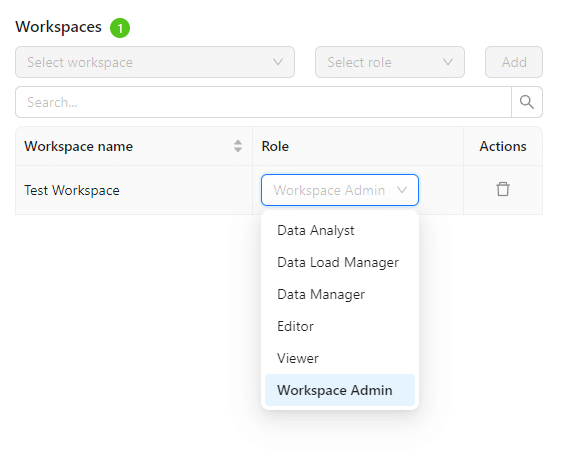
Here’s a quick breakdown:
- Viewer: Read-only access; great for stakeholders who need visibility but no editing power.
- Editor: Can build and modify pipelines, but can’t manage users.
- Workspace Admin: Full control over data and user permissions.
- Data Manager: Handles connections and credentials (think: ad accounts, source access).
- Data Load Manager: Oversees where data lands (warehouses, lakes, etc.).
- Data Analyst: Can transform and analyze data, but doesn’t touch credentials or user roles.
Enterprise-grade security, with fine-grained control—just not fully transparent. If you're after transparency on encryption methods or public-facing details, be prepared to ask, and sign an NDA to see them.
Final Verdict: When to Use Improvado and When to Switch
Choose Improvado if:
- You need a powerful data pipeline, but not an all-in-one solution: If you’ve already got a BI tool like Looker or Power BI in place, Improvado plugs in well behind the scenes.
- You’ve got a technical team: From setting up connectors to managing sync schedules, Improvado assumes some backend knowledge.
- You’re focused on data optimization, not client delivery: If reporting happens somewhere else—and your priority is keeping pipelines clean and custom—Improvado’s your workhorse.
- You want a tight grip over roles and data governance: With granular role-based access and compliance credentials like SOC 2, HIPAA, and GDPR, Improvado checks the boxes for enterprise IT and data security needs.
- You don’t need built-in reporting, white-label dashboards, or drag-and-drop visuals: You’re fine sending data to another platform for final presentation.
But what if what you actually need is fast, on-brand reporting in a single workspace, without bouncing between tools?
If that’s your reality, you’re looking for Whatagraph:
- All-in-one reporting, start to finish: No more stitching together Improvado + Tableau + Slack updates. With Whatagraph, data aggregation, transformation, visualization, and delivery happen in one place.
- Made for marketers, not engineers: You don’t need a data science degree, or a spare afternoon, to get started. If you can run a social media marketing campaign, you can run a report in Whatagraph.
- White-labeled and agency-ready: Brand your reports, manage clients at scale, and automate report delivery.
- Save real time, every week: Whatagraph users consistently cut their reporting time by 30%–70%. That’s time you get back for strategy, creativity, or, let’s be honest, catching your breath.
Ditch the Frankenstack. Try Whatagraph and see what reporting looks like when everything actually works together.


